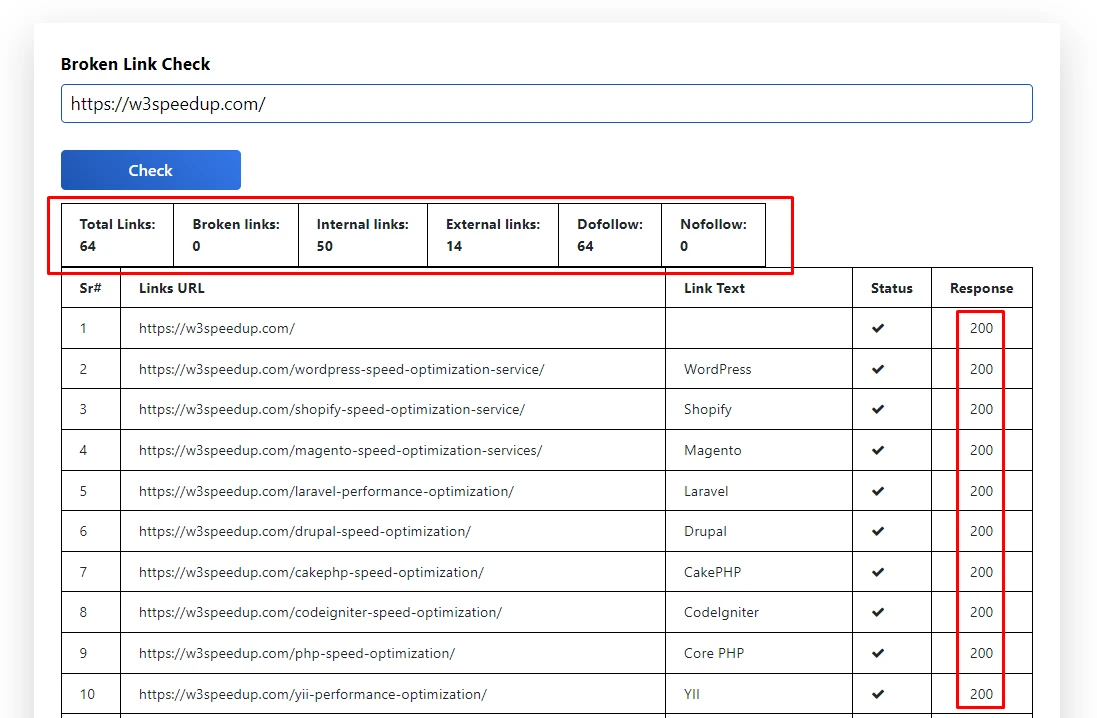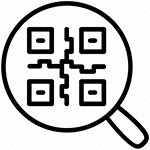⯁ Revive Your Website’s Success with the Ultimate Broken & Dead Link Checker
In today’s digital age, having a robust online presence is crucial for businesses to succeed. Websites serve as the primary point of interaction between companies and their potential customers. It is essential to ensure that websites function optimally and provide a seamless user experience. One aspect of website maintenance often overlooked is checking for broken and dead links.
These links can negatively impact user experience and harm your search engine rankings. In this service page content, we will delve into the importance of regularly checking for broken and dead links on websites and how utilizing a reliable link checker tool, such as a dead link checker or a 404 checker, can benefit your online presence.
⯁ Why Choose Our Website’s Broken Link Checker?
At W3 SpeedUp, we strive to offer you the most effective tool for identifying broken links on your website.
Our free online broken link checker is highly efficient in pinpointing link issues. Designed with user-friendliness in mind, this tool enables you to easily detect and rectify all broken links present on your website.
With the aid of our broken link checker tool, we simplify the process of identifying dead links across your site!
⯁ How to Utilize Our Broken Link Checker?
As your website grows over time, the number of pages containing hyperlinks also increases, making it challenging to keep track of them all. Fortunately, our broken link checker tool offers a convenient solution for detecting broken links on your website.
To initiate the checking process, simply enter your website’s URL into the designated space and click the “Check” button. Our system incorporates a unique algorithm that swiftly processes your request and presents the results promptly.

The broken link checker is designed to be user-friendly, requiring no specialized skills, and accessible to anyone. This invaluable tool allows unlimited searches for website owners, webmasters, and SEO professionals. Moreover, it is free to use without any registration requirements.
Remember, a well-maintained website with no broken links reflects positively on your brand and instills trust in your audience. Invest in a robust link checker tool like Broken Link Checker and make it a regular part of your website maintenance routine. If you are considering staying ahead of your competitors, boosting your organic traffic, and enhancing your overall online presence, it’s highly recommended that you take this step.
⯁ Understanding the various types of links is crucial for enhancing your website’s visibility and ranking.
- Total Links: Total links refer to the number of hyperlinks on a webpage, including internal and external links. Search engines consider the quantity & quality of these links when determining the relevance and authority of a webpage. Websites with a good number of quality links tend to rank better in search results.
- Broken Links: Broken links are hyperlinks that point to non-existent or inaccessible web pages. These links can negatively impact user experience and SEO. When search engine bots encounter broken links, they interpret them as a sign of poor website maintenance. Regularly auditing and fixing broken links on your website is essential to ensure a seamless user experience and maintain search engine rankings.
- Internal Links: Internal links connect different pages within the same website. They are vital in website navigation, user experience, & SEO. Internal link helps search engines understand the structure of your website and establish a hierarchy of importance for different pages. By strategically linking relevant pages together, you can distribute link authority and improve the visibility of your content in search results.
- External Links: External links, also known as outbound links, are hyperlinks that point from your website to other websites. These links provide additional information and resources for your readers. From an SEO perspective, external links can enhance your website’s credibility and authority. When you link to reputable and relevant websites, search engines perceive your website as a valuable source of information, positively impacting your rankings.
⯁ Difference Between Dofollow and Nofollow Links & Their Significance in SEO
Dofollow and nofollow are link attributes that control how search engines crawl and value links. Dofollow links are the default type, allowing search engines to follow the link and pass authority from the originated page to the destination page. Nofollow link, on the other hand, contain the rel=”nofollow” attribute, instructing search engines not to follow the link or pass any authority. Nofollow link are often used for sponsored content, user-generated content, or to prevent the leakage of link authority.
⯁ The Impact of Broken and Dead Links
Broken and dead links can cause frustration for website visitors and hinder their overall browsing experience. When users encounter broken links, they are unable to access the intended content, leading to a negative perception of the website and the brand behind it. This can result in increased bounce rates, lower user engagement, and, ultimately, a loss of potential customers.
From an SEO standpoint, finding and fixing broken links promptly is crucial. Broken link checker tools are essential in identifying and resolving these issues. Using a reliable tool to find broken links ensures that your website’s user experience is optimized, preventing visitors from encountering frustrating dead ends.
Additionally, from an SEO perspective, finding broken links is important for maintaining a healthy website. Search engine crawlers analyze websites to determine their relevancy and quality. When these crawlers encounter broken links, they perceive it as a signal of poor website maintenance and may lower your website’s ranking in search engine results pages (SERPs). Regularly using a tool to find broken links can proactively address these issues and improve your website’s overall SEO performance, leading to higher organic traffic and better visibility in search results.
⯁ The Need for a Reliable Dead Link Checker Tool
Regularly checking for broken and dead links manually can be a time-consuming & tedious task, especially for websites with many pages. This is where a reliable dead link checker tool, such as a 404 checker, comes in handy. These tools automate the process, saving you valuable time and effort.
A good link checker tool, including a 404 checker, scans your website thoroughly, identifying broken links, dead links, and even redirect loops. It provides you with detailed reports and allows you to take necessary actions to fix the issues promptly. By employing such a tool, like a 404 checker, you can ensure that your website remains in optimal condition, providing a seamless browsing experience to your visitors.
⯁ Key Features to Look for in a Link Checker Tool
When selecting a broken link or 404 checker tool for your website, it’s important to consider several key features. Let’s explore these features in detail:
1. Comprehensive Scanning
Choose a tool that offers comprehensive scanning capabilities. The checker tool should be able to scan your entire website, including all internal and external links, to provide a holistic view of the link’s health. This ensures that all links are present during the scanning process.
2. Detailed Reports
The dead link checker tool should provide detailed reports on the broken and dead links it discovers. These reports should be easy to understand, highlighting the specific URLs and linking pages associated with the issues. The tool should also categorize the errors, such as 404 errors so that you can prioritize and address them effectively. Detailed reports enable you to take prompt action in fixing the identified issues.
3. User-Friendly Interface
A user-friendly interface is essential to ensure ease of use and efficient navigation. The tool should have a clear and intuitive layout, allowing you to easily access and interpret the reports. Look for a tool that presents the information in a precise structured manner, making it easy to identify and locate the broken links within your website.
4. Link Management and Monitoring
In addition to identifying broken links, a comprehensive dead link checker tool may also offer monitoring features. This includes the ability to see links directly within the tool, monitor the status of fixed links, and track changes in the link landscape of your website over time. These additional features provide ongoing support for maintaining a healthy link profile.
5. Integration and Compatibility
Consider the integration of the dead link checker tool with your website management systems or platforms. Compatibility with popular CMS or website builders simplifies implementation, usage, and seamless link checking. The integration enables efficient monitoring within your workflow, allowing you to easily find broken links for an optimized browsing experience.
⯁ The Benefits of Using a Reliable Broken or Dead Link Checker Tool
Implementing a reliable link checker tool for your website offers numerous benefits. Let’s explore some of the key advantages:
1. Enhanced User Experience
By regularly checking for broken and dead links, you can confirm that your website provides a seamless user experience. When visitors can navigate through your site without encountering frustrating errors, they are more likely to stay engaged and explore further. This leads to maximizing user satisfaction and a higher chance of conversions.
2. Improved Search Engine Rankings
Search engines give first priority to websites that offer a positive user experience. By proactively identifying and fixing broken links, you signal to search engines that you are committed to providing high-quality content and a well-maintained website. This can result in improved search engine rankings and increased visibility in SERPs, driving more organic traffic to your site.
3. Better Website Reputation
A website with broken or dead links can create a negative perception of your brand. Visitors may perceive it as untrustworthy or poorly managed. On the other hand, a website that consistently provides a seamless browsing experience with no broken links instills confidence in visitors and enhances your brand’s reputation.
4. Time and Resource Savings
Manual checking of links can be a time-consuming task, especially for large websites with numerous pages. By utilizing a reliable link checker tool, you automate the process & save valuable time and resources. This allows us to focus more on other critical aspects of website management and business growth.
5. Proactive Issue Detection
A good link checker tool not only identifies broken and dead links but also detects potential issues that could impact the user experience or SEO performance. By addressing these issues proactively, you can prevent future problems and ensure the smooth functioning of your website.
6. Increased Conversion Rates
A seamless user experience and a well-maintained website contribute to increased conversion rates. When visitors can easily access the information or products they are looking for without encountering broken links, they are likely to convert into customers. By consistently monitoring and fixing broken links, you create a positive browsing experience that encourages conversions.
 Sitemap Page Counter
Sitemap Page Counter Broken Link Checker
Broken Link Checker Word Counter
Word Counter AdSense Revenue Calculator
AdSense Revenue Calculator QR Code Generator
QR Code Generator More Tools
More Tools
